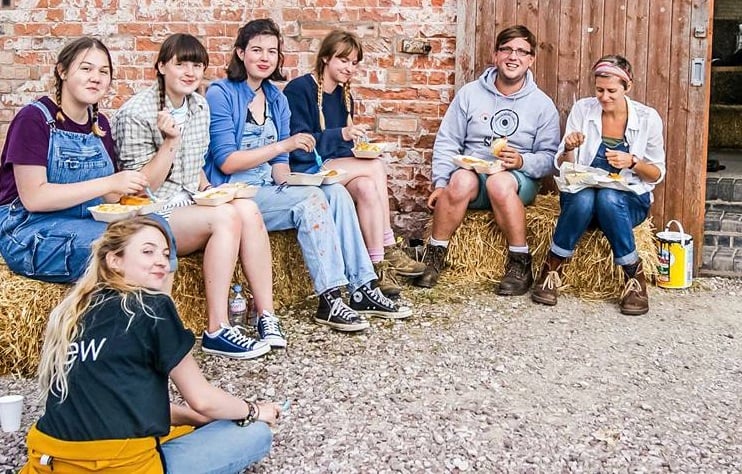
Photo: Rowan Hoban Photography
How to… create a successful volunteer programme
Volunteering in the arts should be an enriching experience, says Cathryn Peach. She shares five tips for designing programmes that motivate, empower and inspire volunteers.
Throughout my time working at Wild Rumpus I have met many volunteers for whom whisking audiences into the avant garde, the wondrous and the magical is second nature. I believe that we should look at our volunteer programmes as a form of enrichment that embeds confidence, provokes action and unearths an inner creativity.
I believe that we should look at our volunteer programmes as a form of enrichment that embeds confidence, provokes action and unearths an inner creativity
We should take time to understand our volunteers – what role they want to play, the skills they have, their motivations and ambitions – and attract a range of people of all ages and with different experiences. The following are, for me, five vital elements to build a successful volunteering programme.
1. Offer a variety of roles
At Wild Rumpus we offer a variety of roles across our events that vary with each production, from artist liaison and stewarding, to information teams and sustainability volunteers.
We alter the roles with each production not just for logistical reasons, but to complement the ethos of the production, what we want the event to do and say and how we integrate our volunteers into this artistic vision.
2. Get to know one another
We take to time to research how to attract volunteers to us and how we might appeal to those who may be more reticent in coming forward. We do this by working with community groups, arts collectives, colleges and universities, as well as advertising widely and supporting families to volunteer together.
The simplest and most effective thing we do is make time to have personal conversations with everyone who applies to volunteer, so that we know we have considered the best role for them. Occasionally, we may reassess someone’s role on site and move them to a better suited area if we haven’t got it quite right.
3. Create a community
We embed an ethos of community but also have designated staff overseeing pastoral care. We also make time for our volunteers to down tools and spend time together. Before a festival we host volunteer weekends in our woodlands that are designed to embed relationships with the production staff.
4. Allow input
A clear artistic vision allows input from a wide range of people, so we take time to listen to feedback, both online and in person. If something doesn’t work, then we talk about why it might be problematic. Leaving the door open for conversation allows for surprising collaborations and insights.
Clear information regarding the volunteer process and physical accessibility is important as it allows a range of people to engage, from the enthusiastic to the tentative, including those with a range of visible or invisible disabilities.
5. Take responsibility
Our volunteers are here to revel in new experiences, learn, form friendships and enjoy themselves. When they do a great job, we celebrate it, and when there are mistakes the production team helps to fix them. We want our volunteers to take ownership but we also want them to feel supported.
We have a comprehensive training schedule where all the production staff introduce themselves. It’s a place for skills to be made known and questions to be asked. There is a responsibility not just to make sure that people are safe but that they are confident, enthused and excited, and that they know where to ask for help when problems arise.
A holistic proposition
Last year I was invited to Taiwan (in response to an article I wrote about our volunteers for ArtsProfessional) to discuss best practice in sustainable and ethical volunteering. What struck me was the correlation between the depth of relationship and success of the scheme. Those who understood their volunteers, and were able to respond to their motivation and skills, had schemes that were thriving.
We visited the Wei Wu Ying Center for the Arts, a giant sculptural vessel that will house a range of arts. Discussions were sparked around how the space could integrate with the park on its doorstep to make it feel like part of the community’s public architecture. It made me think about the volunteers involved in the build of our sites and how seeing the impact of their work gives them a sense of ownership. It seemed ironic that it took a huge venue to make me understand the importance of some of the practices that we take out on to empty grass fields.
By making volunteering part of a holistic proposition, what we are doing is building a festival as they were once imagined – a gathering of people to play, provoke, meet like-minded people, collaborate, discover and build, whether as a volunteer or as an artist.
I hope in the future we will celebrate volunteering more as a sector, and shout out about its abundant benefits. For Wild Rumpus, learning to be flexible and look outwards has made us less precious, more open and hopefully more authentic as an organisation. We gather volunteers along the way and count them as the fabric of our team, some of whom will be the crowning jewels of a shining arts sector in years to come.
Cathryn Peach is the Creative Producer and Head of Programming for Wild Rumpus and Manager of the Northern Festivals Network.
www.wildrumpus.org.uk
Join the Discussion
You must be logged in to post a comment.